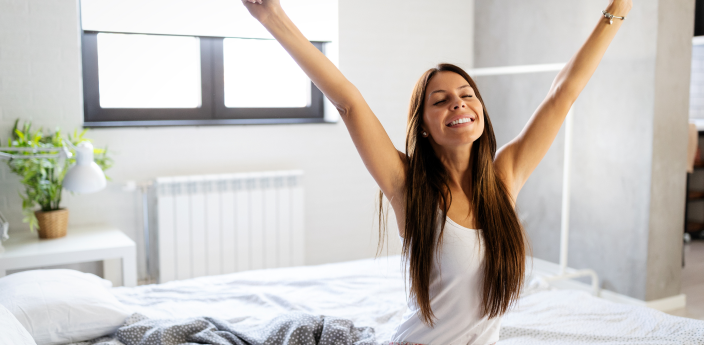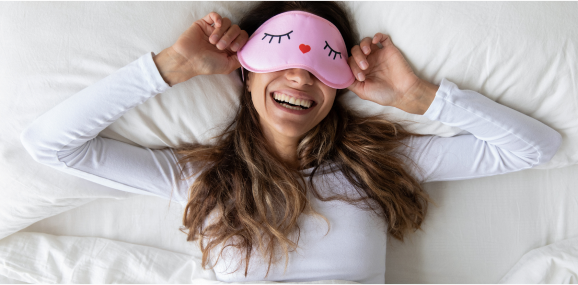We develop our favorite sleep positions during infancy. Even though most of us are placed safely in our cribs in the position recommended by our pediatricians, by the time we’re old enough to roll over, we develop a natural tendency towards a particular pose.
At Hug Sleep, we like to think of ourselves as all-position inclusive. Together, we’ll talk about why your sleep position matters. We’ll also answer the question of which position is most popular, and we’ll give you some of the key benefits of each posture.
We’ll also give you tips for improving each position to make it more comfortable and supportive of your body.
Is Sleep Position Important?
It is, and not just because sleeping in a poor position could cause you to wake up with back pain. If you sleep in a position that doesn’t allow you to get comfortable sleep, you’ll experience fragmented sleep and place yourself at a higher risk of developing a sleep disorder.
Sleeping Soundly
The more times you wake up during the night, the more “fragmented sleep” you experience. Fragmented sleep is characterized by short periods of light sleep (usually REM sleep) followed by a full wakeup or a disturbance that prevents you from reaching deep sleep cycles. The effects of fragmented sleep are daytime sleepiness and grogginess that can be cumulative.
Health Concerns
If you have certain health conditions like sleep apnea or other sleep disorders, your position is really important. Certain positions make sleep apnea disturbances worse. This has a lot to do with the position of your neck and any obstructions that a twisted neck could cause.
If you have a sleep disorder, make sure to speak to your doctor about the safest way to sleep.
Preventing Snores
Your sleep position affects whether or not you snore. For instance, if you sleep on your back, you’re more likely to experience snoring than if you slept on your side or stomach. When sleeping on your back, the tongue relaxes into the back of the throat, causing a slight obstruction in your airway. This is the perfect recipe for sawing logs.
Your sleep position is important, but what position do most of us choose in the first place?
What Positions Are Most Popular?
Most of us know which sleep position we prefer, but few of us go to sleep in one position and wake up in the same one; most people switch positions a few times during the night.
The average number of position shifts is between 10-40 times per night, with a return to our most comfortable and natural sleep position, also known as our instinctive sleep posture, numerous times during the night.
The most popular sleeping position is (drum roll): on your side. Side sleeping makes up 54% of all sleepers’ favorite sleeping positions. Close behind is the back sleeping position, with 37% popularity, followed by stomach sleeping, which is only appealing to about 7% of the population. (Don’t worry, stomach sleepers, we see and support you!)
Let’s cover what’s beneficial for each sleep position and how you can optimize each position for a good night’s sleep.
Which Sleep Position Is Best?
Before we begin, it’s important to understand that many factors — like your health conditions, whether or not you are pregnant, and whether you have any sleep disorders — all play a role in deciding which position is best for you.
That said, here are the best sleep positions for your individual needs.
Back Sleeping Position
Who should use it: People who experience back pain, shoulder pain, or arm pain. If you’ve had rotator cuff surgery, back sleeping is for you.
Sleeping on your back, whether you keep your hands to your side, stretched out, or draped across your body, can help keep your back comfortable and can help ease back pain associated with disc or vertebrae issues.
How to improve: Back sleepers need a super supportive mattress to ensure their spine is safe. You’ll also need to make sure you have a firm pillow that offers plenty of support for your neck.
A good rule of thumb is if your pillow causes your neck to be positioned downward, you need a better pillow. You’ll end up with neck pain and increase your chances of heartburn if your pillow isn’t supportive.
Fetal Position
Who should use it: Everyone!
Side sleepers reign in the popular sleeping position category. Also known as the side sleeping position, the fetal position is also a favorite of most sleep specialists and sleep experts because it is supportive of the neck and provides good spine alignment. Sleeping on your side supports your upper back and lower back.
Another cool fact: During side sleep, experts believe that your brain actually eliminates waste more efficiently than it does in any other sleep position.
Which side is best depends on a few variables:
- Are you a pregnant woman? If so, it’s best for you to sleep on your left side, especially after your first trimester. This allows for better blood flow between the uterus and the heart. If you still find you can’t get comfortable in this position, try a body pillow.
- Do you have high blood pressure? Some studies suggest that sleeping on either side can help decrease your blood pressure.
- If you have heartburn or acid reflux, try sleeping on your left side. Your digestive system isn’t centered in the middle of your body, and sleeping on your left side provides an easier path for digestion, which may alleviate nighttime discomfort from these issues.
- If you have heart disease or other heart-related issues, or if you’ve had heart surgery, sleeping on your right side may be the best position to provide ultimate comfort.
How to improve: Side sleeping is a great way to deal with lower back pain. If you experience low back pain, sleeping in the fetal position with a small pillow between your knees provides perfect spinal alignment and support.
Stomach Sleepers
The least popular sleeping position is sleeping on your stomach. Also known as the front position, some people find it the best way to get rest. While some find it completely uncomfortable, stomach sleepers are a small group joined together by their love of lying with their tummies against the mattress. Unfortunately, it’s not a great position for your spine.
The center of weight in the body is in the midsection, which means when you sleep on your stomach, the natural curve of your spine isn’t supported and bears the weight in your stomach. This position offers little support to your spine and also places your neck in a completely awkward position.
If the only way you can get comfortable sleeping is by sleeping on your stomach, there are ways to try to do it more safely.
How to improve: Firm pillows and stomach sleeping don’t jive. Make sure you have a softer pillow than you’d use if you slept on your back. A stiff or firm pillow can place your neck in a seriously awkward position and cause you to wake up with neck soreness.
Starfish
This position is exactly what it sounds like: lying on your back with your legs spread and your arms bent at the elbows, raised above your head.
Although this isn’t a common sleeping position, some people use it to get better sleep. Because it’s a spinoff of back sleeping, the benefits and drawbacks are similar.
How to improve: By placing a pillow under each knee, you can help align your spine in a more neutral position so you don’t suffer from back pain in the morning.
If you’re concerned that your sleep position could be hindering your spinal health or making it harder for you to fall asleep and stay asleep, don’t worry. With a little work, you can train your body to change positions.
How To Change Your Sleep Position
Sometimes the way you sleep can influence your day-to-day activities and make it hard for you to function. If this sounds like you, trying different sleeping positions can help you get the rest you need and feel better.
But how do you train your body to sleep differently? It’s not as easy as just rolling over.
Invest in a New Mattress
The National Sleep Foundation suggests a smart mattress that can track data from your body weight distribution, mattress firmness, and, yes, your sleep position.
If you aren’t in the market for a new mattress, there are some simpler ways to get the job done.
The Odd-Object Method
By sewing an odd-shaped object like a tennis ball or small foam roller into the front or back of your pajamas, you can prevent yourself from rolling around. You can use any object that prevents a lot of movement.
Buzz-Worthy Method
For the tech-savvy, you can buy an electronic monitor that buzzes to alert you when you move to an “unapproved” position.
Use Your Bedding
You can always use pillows and bedding to prevent yourself from moving around. You can also trick your body into a different position with the type of mattress you choose.
Firm mattresses promote back sleeping, while softer mattresses are better for side sleeping or stomach sleeping. A memory foam mattress can support virtually any sleeping position.
If you try these methods and fail, don’t worry. It’s really common (and natural) for our bodies to gravitate towards one particular position. Finding comfort in that position might be easier than you think.
Great Sleep for All, in Any Position
If you’re in good health and don’t suffer from any bone pain or muscle problems, sleeping in virtually any position that is comfortable will help you get good sleep. But what if you still find it hard to get comfortable before sleeping?
Fortunately, there is a way to use science to help relax your body and mind and prepare yourself for sleep quality that is unparalleled. It starts with your central nervous system.
Your Nervous System
Your sleep and awake times are governed by your circadian rhythm and your sleep drive. These two bodily functions help tell your body when to be asleep and when to be awake. However, there’s a third system that plays a big role in whether or not your body is ready for sleep: your central nervous system.
Though it is broad and complex, there are two parts of your central nervous system that experts say can affect your sleep. Two components, the sympathetic nervous system (SNS) and parasympathetic nervous system (PSNS), work together to provide a yin and yang balance to your sleep and wake cycles.
- SNS. During the daytime, your SNS is in charge. Responsible for keeping you alert, responding quickly to information you receive, and even increasing your heart rate, the SNS is your “fight or flight” response.
- PSNS. When your SNS clocks out for the day, your PSNS takes over the night shift. By slowing your heart rate, helping relax your muscles, and triggering the release of hormones like dopamine and serotonin, your PSNS helps you relax and prepare for sleep.
Sometimes, the system gets confused. Your SNS wants to work overtime, leaving your PSNS struggling to get in its hours. What does that mean for you? Basically, you won’t experience relaxation and might not be able to sleep.
Thankfully, there’s a solution.
Deep Touch Pressure Therapy and Your Sleep
Deep touch pressure therapy, also known as DTPT, is a method of applying gentle pressure to different parts of the body to help stimulate the PSNS. In turn, this helps relax your body so you can ease into a comfortable night of sleep.
The best part is it’s ridiculously easy to do. All you need is an incredibly comfortable, wearable blanket.
The Hug Sleep Sleep Pod
At Hug Sleep, we were tired of being tired. Unable to sleep, we were kept awake by discomfort, feelings of nervousness, and stress. We tried weighted blankets, but they didn't offer the level of comfort we wanted — and they sometimes felt too heavy or hot.
Despite our searching, we couldn’t find what we were looking for… so we invented it.
The Hug Sleep Sleep Pod was designed to give you the perfect amount of DTPT in the form of a lightweight, breathable fabric that you can use alone or under your other bedding. Our four-way stretch material allows for complete mobility (plus total feet freedom) and provides a sensory experience most people find comfortable.
Sleep Comfortably in Any Position
Your sleep position matters. If you suffer from back or neck pain, your sleep position could make it worse.
No matter what position you sleep in, you can increase your comfort and help your body relax for a night of incomparable sleep. The Hug Sleep Sleep Pod is the blanket that hugs you back and helps you get the rest you need.
Sources:
What is the Best Sleep Position for Sleep Apnea? | Sleep Care Online
Discover Your Ideal Sleep Position—Then, Train Your Body to Use It | NY Times

































500,000+ happy customers